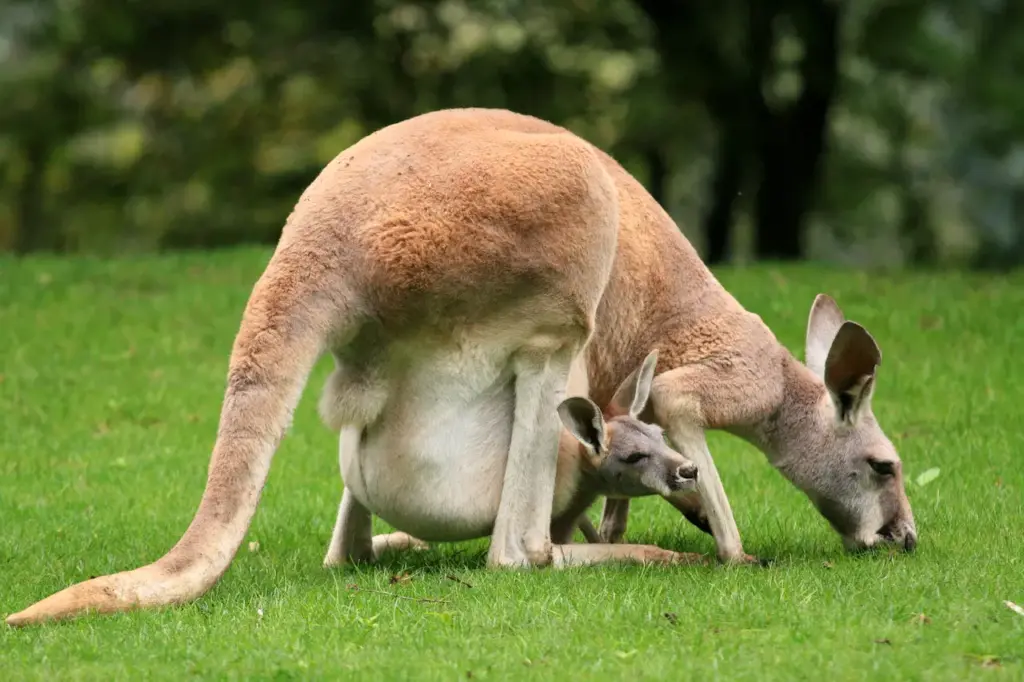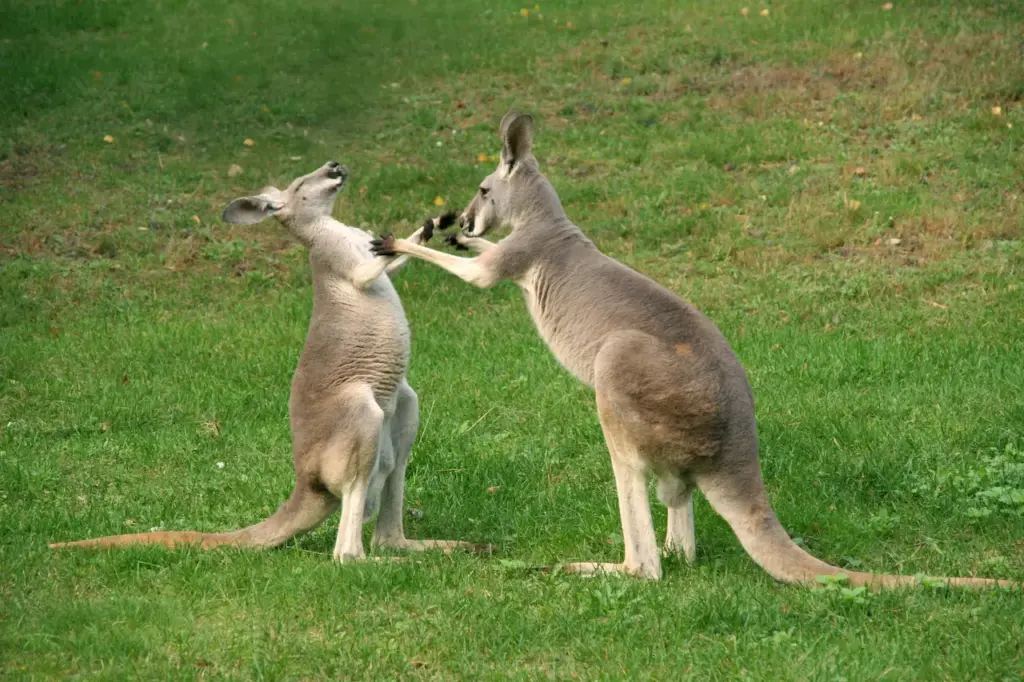What Eats A Kangaroo?
Categories
- Accipitridae (1)
- Acrididae (1)
- Algae (2)
- Alligatoridae (1)
- Amoebidae (1)
- Amphibians (3)
- Anatidae (1)
- Anguillidae (1)
- Arachnids (2)
- Bears (2)
- Big Cats (3)
- Birds (13)
- Bovidae (5)
- Bufonidae (1)
- Camelids (1)
- Cameras (1)
- Canines (13)
- Caridea (1)
- Carnivora (10)
- Castoridae (1)
- Cats (5)
- Cebidae (1)
- Cephalopod (1)
- Cervidae (2)
- Cetacean (1)
- Chondrichthyes (1)
- Crocodilia (2)
- Crustaceans (4)
- Culicidae (1)
- Cyaneidae (1)
- Dasypodidae (1)
- Dasyurids (1)
- Deer (1)
- Delphinidae (1)
- Desktop (1)
- Didelphidae (1)
- Dinosaurs (1)
- Dogs (13)
- Dolphins (2)
- Echinoderms (1)
- Education (10)
- Elephantidae (1)
- Equine (1)
- Erethizontidae (1)
- Erinaceidae (1)
- Farming (1)
- Felidae (5)
- Fish (5)
- Food Chain (31)
- Food Web (2)
- Formicidae (1)
- Frugivore (1)
- Gaming (1)
- Gastropods (1)
- Giraffids (1)
- Great Apes (2)
- Health Conditions (3)
- Herbivore (4)
- Hi-Fi (1)
- Hippopotamidae (1)
- Hominidae (1)
- Insects (10)
- Invertebrates (2)
- Keyboards (1)
- Laptops (1)
- Leporidae (1)
- Mammals (23)
- Marsupials (4)
- Mephitidae (1)
- Microchiroptera (1)
- Mollusks (2)
- Mongoose (1)
- Muridae (1)
- Nocturnal Animals (1)
- Odobenidae (1)
- Omnivore (2)
- Phasianidae (1)
- Phocidae (1)
- Plankton (1)
- Plants (2)
- Primate (1)
- Ranidae (1)
- Reptiles (7)
- Rhinocerotidae (1)
- Rodents (5)
- Salamandridae (1)
- Scarabaeidae (1)
- Sciuridae (2)
- Sharks (1)
- Shellfish (1)
- Sound (1)
- Spheniscidae (1)
- Suidae (1)
- Superfamily Papilionoidea (1)
- Theraphosidae (1)
- What Eats (5)
Introduction
Although kangaroos are not usually considered animals of prey, they can be preyed upon by certain predators who hunt them down for food. Among the most frequent predators of kangaroos are pythons, eagles, and dingoes. Despite their apparent lack of strength, these animals are all well-suited to hunt these massive marsupials.
Nevertheless, some predators hunt kangaroos daily, and others only consume them on rare occasions. Most of the time, these predators avoid adult kangaroos in favour of younger ones.
Because kangaroos are overabundant in many areas of Australia, it takes a healthy population of predators to control the kangaroo population. The majority of predators consume the corpses of kangaroos rather than attacking them. Despite being herbivores, kangaroos do not occupy the lowest rung of the food chain. They developed and adapted to survive in Australia among all the other powerful animals.
Table of Contents
Toggle1. Dingoes
Australia is home to a particular breed of wild dog called the dingo. These dogs hunt at any opportunity, taking down any prey they come across. Although their usual prey is smaller animals, dingoes will attack kangaroos when the chance presents itself. Because they frequently hunt in packs, dingoes have an advantage over larger prey.
Because they can harm cattle, many farmers and ranchers view dingoes as a pest. Furthermore, because they have a history of attacking humans, dingoes are dangerous to people. As a result, several initiatives are in place in Australia to manage the dingo population.
Despite their reputation, dingoes are quite intelligent animals.
They can pick up new skills and are devoted buddies to people. Given their history of sharing food with other members of their pack, dingoes are among the few creatures that show altruism.
2. Domestic Dogs
The domestic dog is the most common predator of kangaroos. Dogs are widespread in Australia, and they frequently hunt kangaroos for food. Even though most dogs aren’t big enough to tackle a mature kangaroo, they might nevertheless pose a threat to the young ones. Usually, dogs would chase down kangaroos and bite them in the neck as a kind of aggression. The kangaroo may suffer severe injuries from this, and in rare circumstances, it may even be deadly.
Feral dogs are also the predators of kangaroos. They are just like domestic dogs, except they haven’t had a lot of human contact. They act like dingoes since they are close relatives of them. Even though these dogs are typically larger than dingoes, they still only bite young kangaroos. They also tend to be more solitary than dingoes, so they rarely go for larger individuals.
If they come upon kangaroo carcasses, feral canines will devour them. Meat from kangaroos is high in iron and protein and low in fat. For this reason, it’s a great way for them to eat.
3. Goannas
In Australia, goannas, commonly referred to as monitor lizards, are a common species of lizard. Being opportunistic hunters, these creatures will consume everything they can bring in, including kangaroos. Goannas typically inhabit areas near water sources because it is convenient for them to ambush their prey. They can take down anything as big as a kangaroo with their razor-sharp fangs and claws.
Although they are not poisonous, monitor lizards can bite painfully. To ward off predators and competitors, they also possess a strong musk gland. Monitor lizards are not thought to be harmful to people despite their size and aggressive behaviour. In Australia, they’re quite common as pets. Although they may live in a variety of environments, they like those that have access to water.
An essential component of the Australian environment is goannas. They aid in controlling the number of smaller animals, which helps stop the overgrazing of plants. Furthermore, they provide a food source for larger predators like dingoes and eagles.
4. Humans
Humans pose the greatest threat to kangaroos because we hunt them for food and leather. Kangaroo meat is regarded as a delicacy in Australia and is frequently served at upscale dining establishments. Additionally, kangaroo hides are utilized to create leather accessories like belts and wallets. The impact on kangaroo populations is increasing due to the growth of the human population.
Loss of habitat is a concern for kangaroos as well. The natural habitat for kangaroos is being lost as a result of human land development for housing and agriculture. As a result, kangaroos have less and less area for living and feeding. Additionally threatened by drought and climate change are kangaroos. Australia is experiencing more and more droughts, which is severely affecting the kangaroo population. Temperature increases brought on by climate change also make it more difficult for kangaroos to survive.
5. Wedge-tailed eagles
The wedge-tailed eagle is among the kangaroo’s most frequent predators. These raptors inhabit the majority of Australia and hunt by taking flight high above the ground and then swooping down to capture their prey. Their talons are so keen that they may easily bring down a kangaroo.
Curiously, carrion—dead animals—is also reported to be consumed by wedge-tailed eagles. They are actually among Australia’s most prevalent scavengers. This implies that practically anything can be consumed by them, such as trash, dead animals, and roadkill. Being highly opportunistic hunters, they will seize any chance to obtain food.
Wedge-tailed eagles are large birds. They can weigh up to 8 kilograms (18 pounds) and have a wingspan of up to 2.5 meters (8 feet). They have wings that are lighter in hue and dark brown plumage. They received their name because of their distinctly wedge-shaped tail.
6. Tasmanian Devils
Only the island of Tasmania is home to the little mammal known as the Tasmanian devil. With no natural predators, this is Australia’s largest land-dwelling carnivore. Being an opportunistic feeder, the Tasmanian devil will consume whatever kind of food it comes across. Carrion, insects, lizards, and tiny animals fall within this category. Although they are not a favored food source, Tasmanian devils will kill and consume kangaroos.
Being a shy and lonesome creature, the Tasmanian devil is most active at night. It frequently withdraws to a den or hollow tree log during the day. These creatures cannot swim, nor are they adept climbers.
Due to a terrible ailment called facial tumours, which has led to a more than 80% population loss, the Tasmanian devil is now endangered. This sickness is deadly and spreads through intimate touch between devils. This illness has no known treatment.
The famous Tasmanian devil is the state animal of Tasmania and one of Australia’s most recognizable species. Australian legislation protects these species, and several conservation initiatives are in place to support an increase in their population.
Conclusion
Naturally, kangaroos have few predators. The majority of hunters in their habitat are deterred by their size and robust build. Generally speaking, other animals only attack baby kangaroos. Large predators such as saltwater crocodiles may attack adult kangaroos.
Humans are the only animals that naturally chase adult kangaroos. With the help of weapons, we can simply hunt them down. In Australia, kangaroos are frequently killed by hunting, agricultural protection, and unintentional car crashes. In the wild, smaller predators like Tasmanian devils and wedge-tailed eagles frequently eat kangaroos as carrion meat.


